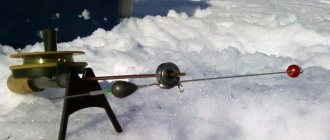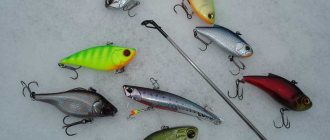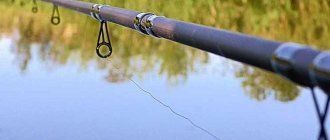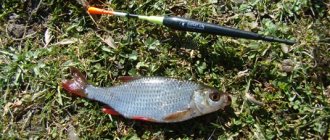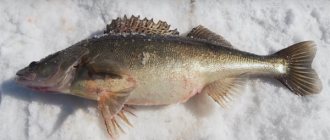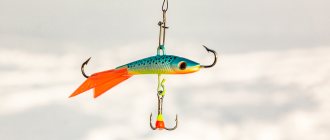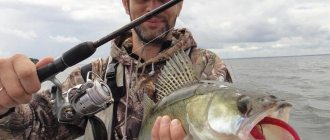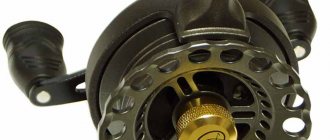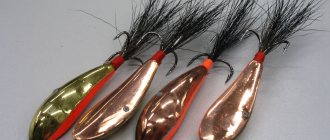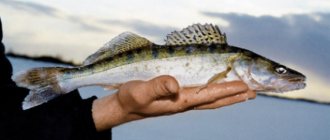Fishing in winter with spoons and balancers is a very popular activity. The success of fishing largely depends on a correctly selected and configured fishing rod, which allows you to carry out baits, record predator bites and confidently hook fish.
Much in the selection of gear for winter trolling depends on the fishing conditions, as well as the predator that the angler is trying to catch. The choice of bait has a significant influence. So a fishing rod for fishing on balance beams will differ from a fishing rod designed for vertical or bottom spinners.
What should a fishing rod be like?
A good winter fishing rod for trolling pike perch must meet a number of criteria, otherwise a pleasant pastime will turn into a nervous breakdown.
- Reliability is the ability to withstand the resistance of a strong predator when aggressively biting, fishing and pulling out of the hole, and the pike perch’s bites are sometimes sharp, it rushes at the prey.
- An elastic and strong whip - a weak one can break, and a hard one can break the tackle or lose it.
- Handle – wooden, coated with oil, wax or paint to protect against water, or made of polymer material (plastic, foam). It has poor thermal conductivity and hygroscopicity - it does not absorb melt water, which freezes, damages the handle and cools the hands. Does not change physical properties at negative temperatures - it is unpleasant when the handle crumbles, peels, deforms when touched or hardens in the cold.
- To install the reel, a reel seat is required.
- The minimum weight will prevent rapid hand fatigue during prolonged fishing for pike perch in winter.
- The length of the fishing rod depends on the fishing conditions, usually it is 30–50 cm, and for lures and large specimens you need a longer rod.
A carbon fiber rod should be used with caution in winter. The material is not particularly “afraid” of frost; the manufacturer regularly improves the compound, giving it the desired properties. With proper use, such a fishing rod will last more than one season. The rules of use are simple:
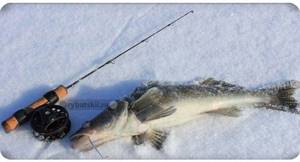
- constantly warm or rub your hands so as not to inadvertently damage the tackle with insensitive limbs;
- do not knock or throw the fishing rod itself or other objects at it;
- Before use (taken out of a warm car), you should remove the cover and give it a few minutes for acclimatization - cooling
- to ambient temperature.
Remember: the stronger the frost, the more sensitive carbon fiber is to mechanical damage.
The main attention should be paid to the ease of working with the fishing rod: so that it fits comfortably in the hand, does not absorb moisture, and does not cause discomfort and rapid fatigue.
Winter reel for pike perch
A reel is an important piece of equipment for a winter fishing rod for pike perch; it has its own requirements:
- Smooth rotation in the cold.
- Sufficient spool capacity with a small margin.
- Equipped with a ratchet and a friction clutch (brake) to prevent breakages during strong jerks during hooking.
- A regulator is desirable to control the ease of rotation.
- The quality of the brake is its reliability and smoothness.
- It is preferable for the drum with the fishing line to be hidden in the housing - it reduces the likelihood of moisture getting on the fishing line with subsequent freezing and chafing of the core, jamming the reel mechanism. As an alternative, tackle with large ventilation holes through which moisture from the fishing line partially evaporates.
- A winter reel should weigh as little as possible.
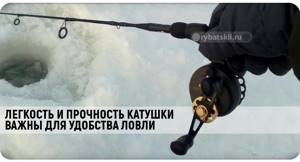
As with a fishing rod, the reliability of the gear is important.
Nod for catching pike perch
A nod often acts as a bite indicator in winter; it also allows you to play with bait to attract a predator. Taking into account the preferences of pike perch - they love low-amplitude play with long pauses - the nod for a winter fishing rod should be moderately elastic in order to slowly lower the bait, slowly stop it at the end point and just as slowly lift it up.
Absorption of moisture and hardening in frost are contraindicated.
A variety of materials are used as a nod: polymer tubes, springs, lavsan and other thermoplastics, rubber, boar bristles. It is desirable to be able to adjust its length; it is selected near the hole experimentally. The advantage is several fishing rods with different nods or nods themselves.
Kinkless winter fishing rod for pike perch
Kinkless winter tackle for pike perch is useful for catching a large predator in the dead of winter, when it leads a passive lifestyle and reacts weakly to the movements of potential food. The bite indicator is its end, because the bait is directly connected to the hand through a fishing line and a fishing rod. Kickless fishing rods are larger in size (length reaches 1 m) and do not always fit in a box; they are more massive. Particular attention is paid to the weight and material of the rod, its rigidity and reliability, taking into account operating conditions. Do not forget about the behavior and properties of the whip, which are determined experimentally.
See the top rating of boxes for winter fishing and how to choose the right model for yourself.
Do you need to make a fishing rod yourself?
Real fishermen will answer this question only positively. Each fisherman must collect his own tackle for himself; there is simply no point in relying on someone else.
Many people come to fishing tackle stores and ask for a ready-made fishing rod for ice fishing. Demand creates supply, modern craftsmen collect tackle, but the fisherman knows nothing about the quality of the fishing line or the tackle itself.
A fishing rod assembled by yourself will give you confidence in your own abilities; when you go, you will blame yourself, not that guy.
Fishing line for pike perch in winter
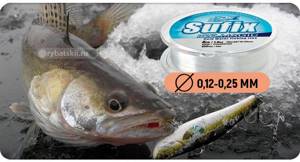
Braid for winter fishing is only suitable for fishing with a reel - it quickly freezes, which causes inconvenience: it becomes slippery and cools your hands. Mono fishing line is preferable, but the final choice is up to the fisherman.
- The diameter of the line for winter fishing for pike perch is selected based on the weight of the expected catch, equipment and taking into account the harsh operating conditions. It should be strong (strength and thickness are not always interrelated), but thin and moderately rigid. For winter, monofilament with a thickness of 0.12-0.2 mm is suitable. For large prey, a thicker fishing line is required - 0.25 mm.
- Lack of memory - after unwinding from the reel, the vein should not twist, repeating the shape of the spool, since the turns interfere with normal fishing and management of the tackle.
- Transparent or invisible to fish. A colored or thick vein increases the chances of scaring off fish.
- Resistance to abrasive wear - friction against ice causes minimal damage to the core. In addition to the accelerated wear of low-quality fishing line, abrasions repel pike perch, since they have a different refractive index of light rays.
- Hydrophobicity or the ability not to absorb moisture - preferably monofilament, if financially possible - with a special water-repellent impregnation. Braid is known for freezing ice.
Like any fishing line, it should hold knots perfectly in the cold and be crushed.
The use of leashes and carabiners is not recommended - they can scare away a cautious predator.
Types of equipment
In winter, fishing fans approach the choice of equipment with the utmost seriousness. First of all, you need to prepare your rod for ice fishing. It depends on which method is chosen: plumb trolling, fishing with a float or jig.
Fishing rods for winter fishing without a reel
Traditionally, such gear was not originally intended for any kind of line storage devices. It was wound around a handle or whip (fishing rod). The handle itself was wooden, plastic or foam. It was specially cut so that the fishing line would not fall. This design had a lot of disadvantages:
- Gradual deformation of the handle or whip due to the cutting ability of the fishing line.
- It is not possible to precisely adjust the trigger length.
- When the rod gets into the water, the line freezes. It becomes very difficult to reel it in when suddenly you urgently need to change the fishing depth.
However, if you consider that such equipment can easily be made without special skills and financial investments, you can understand why such a winter fishing rod is still found among many amateurs and professionals of ice fishing.
Adherents of fishing that does not use baits use homemade foam fishing rods. Its low weight makes it possible to play with a small jig. For shallow depths, a supply of fishing line of 5-7 meters is sufficient.
A similar, only larger, tackle is called “filly” . It has gained popularity among fans of fishing using float equipment. In this case, adjustment of the line tension between the float and the fishing rod is not required, and installation on an ice surface does not become a problem.
The rod itself is made of wood with an elastic structure; fiberglass has recently been used for these purposes. The handle on the butt is made from various materials. You can, for example, adapt a handle from a spinning rod. Many fishermen make a reel from two pieces of stainless wire and install them at a standard distance from each other. This allows you to accurately measure the distance to which the fishing line is immersed and its remaining amount. This cheap fishing rod has been tested on many reservoirs since Soviet times.
Reel tackle
Nowadays fishing rods and reels have appeared and become quite popular. Initially, domestic enterprises began producing similar products with two winding devices. But it turned out that, in comparison with Japanese and Finnish fishing rods for winter fishing, they are too unreliable and cumbersome.
All such devices are made with a separate handle or a reel plays its role. It can be either open or placed in a strong case. Both designs have their own characteristics.
If you plan to use thin fishing line, then to protect it from freezing when moisture gets in, it is recommended to use a reel in a housing. Most manufacturers use plastic or foam for these purposes, which does not protect it from deformation or breakage upon impact. Dents on the casing cause the line to jam when it is released. Many anglers upgrade this part of the winter fishing rod themselves.
For fishing with a balance beam or spoon, use a thick fishing line. It usually does not freeze and there is no point in using covers for coils. In addition, the drums for this method of fishing have a large diameter and the manufacture of a casing will significantly make the fishing rod heavier.
Rigging a winter fishing rod for pike perch
A fishing rod for pike perch for winter fishing is equipped depending on the fishing method. Popular rigs: spinner, winter jig for pike perch, donka, jig.
Winter fishing rod for trolling pike perch and fishing with a balance beam
Flashing - catching pike perch using a shiny artificial bait that plays in the water column. It has an offset center, which causes a variety of movements when lowering. A pike-perch rod for fishing from ice with bait consists of a rod with a whip and a ring at its end (can be replaced with a cambric - a piece of wire insulation of the appropriate diameter), a reel and the bait itself. The most attractive bait for pike perch is a vertical spinner. Horizontal and twitching spoons are used less frequently.
Balancer is a horizontal bait in the form of a small fish with one or more hooks. The so-called wings, located closer to the tail of the balancer, give its movements a peculiar game.
Read how to catch pike perch in winter using a balance beam and the top best bait models.
Mormyshka
In addition to artificial baits, pike perch are also interested in bait in the form of small fish (anchovy, sprat), bloodworms, worms, and fish meat. You can deceive him by slipping in scented foam rubber or silicone. For pike perch you need a larger and more massive jig than for peaceful fish, for example, a jig head. In still water it is used together with a nod; on a river, the game is partially or completely replaced by a current and an elastic whip.
On the jig
Catching pike perch using a jig is widespread. True, it is unlikely that you will be able to pull out a trophy specimen with such a fishing rod. A large predator often stands alone under a snag, waiting in ambush for fairly large prey - a fish weighing 200-300 grams. It is simply not profitable for him to waste energy on hunting for small things. However, pike perch jigs work great for medium and small predators. The jig for pike perch is large, heavy, with a high-quality sharp hook. It is somewhat reminiscent of a burbot snitch. The same sprat, a strip of fish or, for example, an elastic band from a balloon is placed on the hook of the tackle.
Small pike perch are often taken on the devil or the bald when fishing for perch at depth. The equipment for pike-perch jigs is the same as for trolling - the weight of the baits is comparable, the playing technique is similar. For a fishing rod with a jig (jig head) in a strong current, a technique that works well for pike perch is available - moving the bait along the bottom using the traction force of the water. This way, you can fish a larger area from each hole, making it easier to find points.
DIY winter tackle for pike perch
There is a huge selection of fishing rods on store shelves, but experienced fishermen prefer to make a winter fishing rod for pike perch themselves. To do this, you will need available materials, tools and the usual gear. It all depends on imagination, the ability to process materials (wood) and their availability.
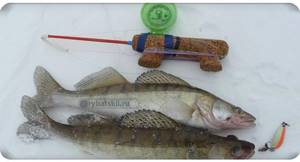
You can use a purchased nod or make it yourself from boar bristles, a polymer tube, or metal (a spoke from an umbrella or a bicycle wheel).
A whip can also be purchased from carbon fiber or made from a thin wood twig, for example, elm or juniper, or a metal knitting needle. The main thing is that you can easily attach a ring or cambric to the whip to fix it and pass the line through.
Fishing rod - made from wood, polystyrene foam, polystyrene foam, bark... almost anything. The workpiece is processed using a knife or cutter until it is given the desired shape. A seat is made for the reel, unless a reel and a hole for passing the fishing line to it are used instead. Using sandpaper, the shape is brought to perfection.
Other equipment for catching pike perch in winter is purchased: fishing line, jig, reel, spinner or other bait.
Installation of a winter pike-perch fishing rod consists of:
- installation of the reel and whip;
- attaching a ring made of metal or a polymer tube to the end of the whip for a nodless version or a nod;
- passing the fishing line through the ring/nod and the hole to the reel;
- winding the required amount of fishing line onto the spool;
- tying a jig or bait.
After assembly, it is necessary to check the combination of jig weight and nod play.
For sprat
In the Volga basin, pike perch are often caught using sprat. This fish is the main food source for fanged fish in the Volga basin. Live sprat can be used as live bait on the bottom, but more often frozen fish from the store are used for hooking onto a spoon, jig or hook. This is convenient for the townspeople of the Volga region - I bought frozen sprat in a department store - and there is no need to fool myself with searching for live bait or other bait. Yes, and the striped one on the Volga takes well on sprat. Most often, the sprat is planted on the hook of a diverter leash, a jig head, a jig or a special tackle. There's a lot going on here. You can also fish for pike perch in winter for fry in other regions, using fish species found in the reservoirs of those places. It doesn’t hurt to check the sprat, even if it’s not found there. You can also try frozen capelin or sprat.
Rating of the best winter fishing rods for pike perch

The market is replete with a variety of fishing rods, including many models for hunting pike perch from the ice.
PIERCE ABS
PIRS ABS is a domestically produced plastic fishing rod with a voluminous reel with a brake. The whip is suitable for fishing out small specimens; for a large predator it is a bit flimsy. After replacing the latter, it becomes an excellent choice for fishing pike perch from the ice. Equipped with a stand for installation in a horizontal position. Made from imported brands of wear-resistant plastics for use in harsh conditions.
Karismax Maxtreme 5
Karismax Maxtreme 5 is a winter fishing rod of average weight and size, made of high-tech plastic that is frost-resistant. Equipped with a lavsan nod for fishing with a jig and a polyurethane overlay on the handle. The latter additionally secures the jig during transportation and storage.
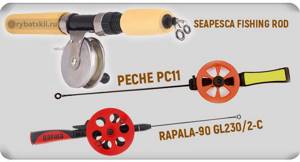
Peche PC11
Peche PC11 is notable for its coil with huge ventilation slots, through which moisture evaporates under the influence of strong winds, even in the cold. Equipped with a rubberized handle that does not collect snow and does not absorb water, it is used to fix the jig. Equipped with quick-release whips.
Seapesca Fishing Rold
Seapesca Fishing Rold is a range of trolling rods. Equipped with an oversized handle with an overlay, a durable steel reel with a rotation lock and a folding whip with a pair of pass rings.
Rapala-90 GL230/2-C
Rapala-90 GL230/2-C is a Finnish tackle made from frost-resistant plastic. The basis of the rod – the whip – is thin, elastic, and does not deform when subjected to strong bending. The quality of the reel is also excellent: it rotates easily without play or jamming. A reliable clutch works reliably in the event of a hook or a sharp bite from a large predator.
The best winter fishing rod for pike perch, of course, is made independently for yourself or determined experimentally. In fishing for pike perch, tackle does not play a major role. Much more important is the ability to use it, to know where and when to look for a predator, what to catch with, etc. All this is determined empirically.
